Home | Tours | Trip Reports | News | Team | Calendar | Links | Contact | Store | Mailing List
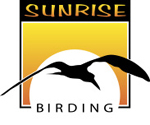
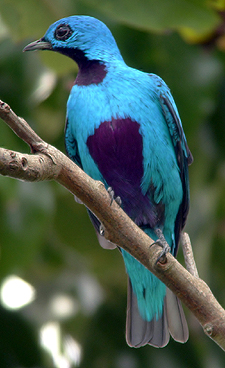 PANAMA
PANAMACanopy Tower & Lodge
TRIP REPORT
August 24 - September 3, 2010
PHOTOS> TRIP REPORT> SPECIES LIST(PDF)>
Leaders: Gina Nichol, Steve Bird, & Carlos Bethancourt
Blue Cotinga
Photo: Carlos Bethancourt
August 24 - Arrivals
Most of the group arrived late in the evening except from Allan and Janice who were already enjoying Panama on their own for a couple of days. Steve, Christian, Carol and Leonard were on the same flight with Miss Panama whose adoring fans kept them entertained while they waited for their transfer to Canopy Tower.
August 25 - Canopy Tower, Semaphore Hill, Ammo Dump
The overnight rain subsided and at dawn we were up on the top deck of the Canopy Tower (Photo: Gina Nichol) birding around the empty 30-foot high geotangent dome that once held a radar system on top of Semaphore Hill in the heart of 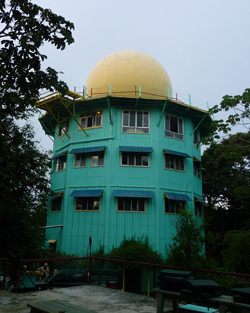 Soberanía National Park. Admiring the sunrise, lighting up the low cloud in the valleys and along the Panama Canal, we got our first look at the amazing 360-degree view of the jungle canopy and were looking at pairs of Red-lored Parrots flying past us. A Great Tinamou was calling from the forest floor below and some Palm Tanagers were investigating us as they perched on some wires attached to the ball. A Collared Forest-Falcon called nearby and finally flew from a tree just below us disappearing into the forest. A Scarlet-rumped Cacique visited a nearby Cecropia and a White-necked Jacobin perched at the top of a tree was seen at eye level. Golden-hooded and Plain-colored Tanagers also visited the Cecropia and a Black-breasted Puffbird posed nicely on a branch below us. A Squirrel Cuckoo was backlit by the rising sun and there were Band-rumped Swifts and Blue-and-White Swallows around. A pair of Scaled Pigeons showed well at the top of a tree near a bright Blue Dacnis and our first Brown-hooded Parrot was scoped on a dead tree that also held two Keel-billed Toucans. It was evident immediately that this was a truly unique and amazing place to bird!
Soberanía National Park. Admiring the sunrise, lighting up the low cloud in the valleys and along the Panama Canal, we got our first look at the amazing 360-degree view of the jungle canopy and were looking at pairs of Red-lored Parrots flying past us. A Great Tinamou was calling from the forest floor below and some Palm Tanagers were investigating us as they perched on some wires attached to the ball. A Collared Forest-Falcon called nearby and finally flew from a tree just below us disappearing into the forest. A Scarlet-rumped Cacique visited a nearby Cecropia and a White-necked Jacobin perched at the top of a tree was seen at eye level. Golden-hooded and Plain-colored Tanagers also visited the Cecropia and a Black-breasted Puffbird posed nicely on a branch below us. A Squirrel Cuckoo was backlit by the rising sun and there were Band-rumped Swifts and Blue-and-White Swallows around. A pair of Scaled Pigeons showed well at the top of a tree near a bright Blue Dacnis and our first Brown-hooded Parrot was scoped on a dead tree that also held two Keel-billed Toucans. It was evident immediately that this was a truly unique and amazing place to bird!
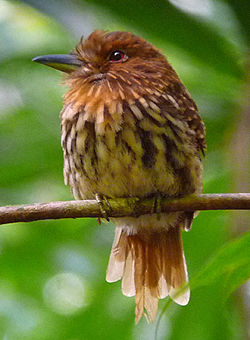 After breakfast we had an orientation by our guide Carlos and soon met up again for a walk down Semaphore Hill. Just outside the lodge there were hummingbird feeders that attracted Blue-chested and Violet-bellied Hummingbirds and a White-vented Plumeleteer. Not far down the road, Carlos scoped a Rufous Tree Rat roosting in a tree cavity. The birding was good as we could see into the semi deciduous tall forest from the road. Species seen included Rufous Motmot, Brown-capped Tyrannulet, a Black-and-White Warbler (one of the first fall migrants), a male Blue-crowned Manakin, Black-cheeked Woodpecker, a pair of Western Slaty Antshrikes, Blue-black Grosbeak, Plain Xenops, a few Dot-winged Antwrens and some White-shouldered Tanagers. The day was heating up and we enjoyed a brief respite when a truck arrived with cold drinks. Once refreshed, we continued walking down adding superb looks of a Scaly-throated Leaftosser, followed by female Slaty-tailed Trogon, Bright-rumped Attila, Plain-brown Woodcreeper, and a Hoffmann’s Two-toed Sloth spotted by Allan. A White-whiskered Puffbird (Photo: Gina Nichol) was very confiding and allowed close approach and numerous photos. A Black-throated Trogon flew in and landed overhead offering good views and down the bank a Bicolored Antbird was watched bathing in a small pool. A Southern Bentbill gave us a challenge but eventually showed for us. As we continued down, we added several more species to our growing list including a male Slaty-tailed Trogon, Fasciated Antshrike, the first of many Central American Agoutis, Cocoa Woodcreeper, Chestnut-backed Antbird, Black-bellied Wren, two displaying Broad-billed Motmots, and a high flying Black Hawk-Eagle.
After breakfast we had an orientation by our guide Carlos and soon met up again for a walk down Semaphore Hill. Just outside the lodge there were hummingbird feeders that attracted Blue-chested and Violet-bellied Hummingbirds and a White-vented Plumeleteer. Not far down the road, Carlos scoped a Rufous Tree Rat roosting in a tree cavity. The birding was good as we could see into the semi deciduous tall forest from the road. Species seen included Rufous Motmot, Brown-capped Tyrannulet, a Black-and-White Warbler (one of the first fall migrants), a male Blue-crowned Manakin, Black-cheeked Woodpecker, a pair of Western Slaty Antshrikes, Blue-black Grosbeak, Plain Xenops, a few Dot-winged Antwrens and some White-shouldered Tanagers. The day was heating up and we enjoyed a brief respite when a truck arrived with cold drinks. Once refreshed, we continued walking down adding superb looks of a Scaly-throated Leaftosser, followed by female Slaty-tailed Trogon, Bright-rumped Attila, Plain-brown Woodcreeper, and a Hoffmann’s Two-toed Sloth spotted by Allan. A White-whiskered Puffbird (Photo: Gina Nichol) was very confiding and allowed close approach and numerous photos. A Black-throated Trogon flew in and landed overhead offering good views and down the bank a Bicolored Antbird was watched bathing in a small pool. A Southern Bentbill gave us a challenge but eventually showed for us. As we continued down, we added several more species to our growing list including a male Slaty-tailed Trogon, Fasciated Antshrike, the first of many Central American Agoutis, Cocoa Woodcreeper, Chestnut-backed Antbird, Black-bellied Wren, two displaying Broad-billed Motmots, and a high flying Black Hawk-Eagle.
During lunch, we were greeted by Raul Arias de Para, the owner of Canopy Tower and Lodge. Raul welcomed us and wish us a successful trip. After lunch, we gathered for an afternoon at the 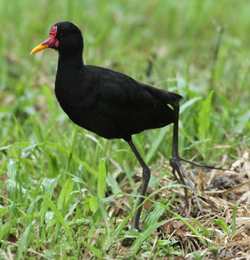 Gamboa Ammo Dump just north of Gamboa, on the way to Pipeline Road. As we assembled, a Stripe-throated Hermit came into the feeders and a Short-tailed Hawk flew over low. We boarded our open truck, El Tinamou and headed down Semaphore Hill making a short stop at the beginning of the Plantation Trail where a couple of Spotted Antbirds crossed into the forest quickly and a Purple-throated Fruitcrow was seen well. During our stop to cross the Gamboa Bridge, we ticked our first of many Tropical Kingbirds and noted several Gray-breasted Martins perched on the power lines.
Gamboa Ammo Dump just north of Gamboa, on the way to Pipeline Road. As we assembled, a Stripe-throated Hermit came into the feeders and a Short-tailed Hawk flew over low. We boarded our open truck, El Tinamou and headed down Semaphore Hill making a short stop at the beginning of the Plantation Trail where a couple of Spotted Antbirds crossed into the forest quickly and a Purple-throated Fruitcrow was seen well. During our stop to cross the Gamboa Bridge, we ticked our first of many Tropical Kingbirds and noted several Gray-breasted Martins perched on the power lines.
When we arrived at the Ammo Dump, there were two fairly tame Wattled Jacanas (Photo: Steve Bird) feeding on the ground near the road allowing close views and photos. In the trees lining either side of the road were Streaked Flycatcher, Panama Flycatcher, Social Flycatcher, Thick-billed Euphonia,Crimson-backed Tanager, Clay-colored Thrush, Blue-gray Tanager, and a pair of Barred Antshrikes. Further on there was a tree full of Gray-headed Chachalacas and around the fence for the dump we found Black-tailed Flycatcher, Red-crowned Woodpecker, Buff-breasted Wren, Piratic Flycatcher and several Pale-vented Pigeons. Both Band-rumped and Short-tailed Swifts were flying above and a House Wren appeared next to the fence.
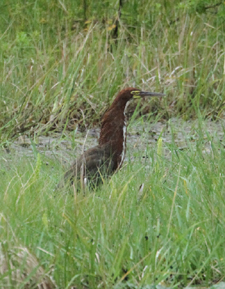 We moved over to the other side of the pond and found a pair of Plain Wrens feeding busily in a tree and nearby a Yellow-bellied Elaenia. In the grasses along the road, there was Blue-black Grassquit, Variable, Yellow-bellied and Ruddy-breasted Seedeaters. We positioned ourselves to see into a marshy area which held Black-bellied Whistling Ducks, a few Greater Anis, Purple Gallinule, Great Egret, Rufescent Tiger-herons (Photo: Steve Bird), Smooth-billed Anis, Green Herons, and Lesser Kiskadees. Several Southern Rough-winged Swallows were flying around, a Southern Lapwing flew over, and a Snail Kite was scoped in a distant tree. We could hear a White-throated Crake calling from the marsh so Carlos played the call prompting an adult bird to swim across some open water toward us. Amazing! A couple of juveniles were also interested allowing varying views through the grasses. On our way back, four Tropical Mockingbirds were seen perched on the power line and as we turned off the main road up toward the tower, a White-necked Puffbird showed well.
We moved over to the other side of the pond and found a pair of Plain Wrens feeding busily in a tree and nearby a Yellow-bellied Elaenia. In the grasses along the road, there was Blue-black Grassquit, Variable, Yellow-bellied and Ruddy-breasted Seedeaters. We positioned ourselves to see into a marshy area which held Black-bellied Whistling Ducks, a few Greater Anis, Purple Gallinule, Great Egret, Rufescent Tiger-herons (Photo: Steve Bird), Smooth-billed Anis, Green Herons, and Lesser Kiskadees. Several Southern Rough-winged Swallows were flying around, a Southern Lapwing flew over, and a Snail Kite was scoped in a distant tree. We could hear a White-throated Crake calling from the marsh so Carlos played the call prompting an adult bird to swim across some open water toward us. Amazing! A couple of juveniles were also interested allowing varying views through the grasses. On our way back, four Tropical Mockingbirds were seen perched on the power line and as we turned off the main road up toward the tower, a White-necked Puffbird showed well.
After dinner, we went on a night drive down Semaphore Hill. As we assembled to get on the open back truck, we could hear a Mottled Owl calling not far away. Just a few feet from the lodge gate, we found the owl which showed very well for us! Good start! During the drive we had great views of Brown-throated Three-toed Sloths, Hoffmann’s Two-toed Sloth, and a Nine-banded Armadillo. A Common Potoo was heard and eventually seen as it flew among the trees above us. We also heard Spectacled Owl and Choco Screech-owl but neither was close enough to get a glimpse of.
August 26 – Pipeline Road
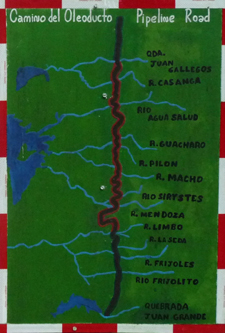 Today we birded the famous Pipeline Road that begins in the town of Gamboa and stretches 17 kilometers north at the east bank of the Panama Canal. The road was built during World War II to service a pipeline meant to transfer fuel from one ocean to the other. The pipeline itself was never used but the path of the road through lush secondary, old growth forest is world renowned for its birding opportunities.
Today we birded the famous Pipeline Road that begins in the town of Gamboa and stretches 17 kilometers north at the east bank of the Panama Canal. The road was built during World War II to service a pipeline meant to transfer fuel from one ocean to the other. The pipeline itself was never used but the path of the road through lush secondary, old growth forest is world renowned for its birding opportunities.
As we departed the Tower, a troupe of Geoffroy’s Tamarins was seen in a large tree just outside the building. Our first birding stop was quite productive yielding Rusty-margined Flycatcher, a flock of Golden-hooded Tanagers, Slate-colored Grosbeak, Buff-throated Saltator, Black-bellied Wren, Black-chested Jay, Squirrel Cuckoo, Blue-hooded Parrots, Forest Elaenia, Dusky-capped Flycatcher, Blue Dacnis, Yellow-crowned Euphonia, and a pair of Crimson-crested Woodpeckers that showed very well in a bare tree. Christian found a Northern Tamandua climbing a trunk behind a thick tangle and there were Lesser Swallow-tailed Swifts, Gray-breasted Martins, and good numbers of migrating Cliff Swallows overhead.
Carlos was picking up several species by sound and this led to excellent views of the elusive Rosy Thrush-tanager and a male Golden-collared Manakin. Female Violaceous and Black-throated Trogons were also seen.
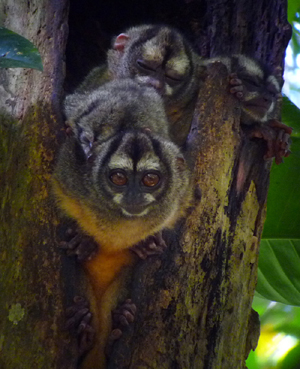 We moved on to the official entrance of Pipeline Road and walked a short distance off the trail to find four Panamanian Night-Monkeys (Photo: Gina Nichol) roosting in a tree cavity. Views of these incredible animals and their antics as they repositioned themselves at the entrance to the cavity were unbelievable and led to a much enjoyed photo session. Back out on the road, we found Spotted Antbird, Checker-throated and White-flanked Antwrens, Blue-crowned Manakin, and eventually good views of Song Wren. We enjoyed a picnic lunch and short rest before continuing up the road to find Moustached Antwrens which allowed great views. Also seen were Ruddy-tailed Flycatcher, a nice male Blue-crowned Manakin, and a couple of Gray-headed Tanagers. A Thrushlike Schiffornis came in amazingly close and a Stripe-throated Hermit was seen perched and then feeding on heliconias. On the way back toward the lodge, we stopped for a pair of Bat Falcons perched in an open tree just outside the village of Gamboa. Another stop at some feeders produced six Central American Agoutis that appeared as soon as Carlos put some bananas out on the table. We watched as other birds arrived including Blue-gray Tanager, Crimson-backed Tanager, Palm Tanager, Orange-chinned Parakeets, Streaked Saltator, Lemon-Rumped Tanager, a young male Red-legged Honeycreeper, and some Ruddy Ground-doves. A Rufous-tailed Hummingbird foraged in some nearby flowers and came in for close views.
We moved on to the official entrance of Pipeline Road and walked a short distance off the trail to find four Panamanian Night-Monkeys (Photo: Gina Nichol) roosting in a tree cavity. Views of these incredible animals and their antics as they repositioned themselves at the entrance to the cavity were unbelievable and led to a much enjoyed photo session. Back out on the road, we found Spotted Antbird, Checker-throated and White-flanked Antwrens, Blue-crowned Manakin, and eventually good views of Song Wren. We enjoyed a picnic lunch and short rest before continuing up the road to find Moustached Antwrens which allowed great views. Also seen were Ruddy-tailed Flycatcher, a nice male Blue-crowned Manakin, and a couple of Gray-headed Tanagers. A Thrushlike Schiffornis came in amazingly close and a Stripe-throated Hermit was seen perched and then feeding on heliconias. On the way back toward the lodge, we stopped for a pair of Bat Falcons perched in an open tree just outside the village of Gamboa. Another stop at some feeders produced six Central American Agoutis that appeared as soon as Carlos put some bananas out on the table. We watched as other birds arrived including Blue-gray Tanager, Crimson-backed Tanager, Palm Tanager, Orange-chinned Parakeets, Streaked Saltator, Lemon-Rumped Tanager, a young male Red-legged Honeycreeper, and some Ruddy Ground-doves. A Rufous-tailed Hummingbird foraged in some nearby flowers and came in for close views.
Our last stop was at Gamboa Resort where we picked up Spotted Sandpipers and Common Moorhens on the way in. Common Tody Flycatcher and Yellow-crowned Tyrannulet were seen flitting around the trees in the car park and in the pond there were Purple Gallinules and an adult Striated Heron feeding some half-grown young birds. In the trees across the pond, there were Greater Anis and our first Osprey of the trip flew over. We made our way back up to the Tower for the night and reviewed our ever growing list of sightings after a nice dinner.
August 27 – Achiote Road and San Lorenzo
Today we headed north from Canopy Tower to the Caribbean west bank of the Panama Canal and birded Achiote Road and the area contiguous to the San Lorenzo National Park. A very early start had us driving in the dark and by the time we reached Gatun Locks it was daylight. We ticked our first Magnificent Frigatebirds as we waited in line to cross Gatun Locks. We crossed over the Chagres River heading north and at our first stop along the road, we had Boat-billed Flycatcher, a perched Yellow-headed Caracara, and Masked Tityra. Gina spotted two Spot-crowned Barbets feeding on some trees near the road and we also had Black-tailed Trogon, Yellow-tailed Oriole, and a Long-billed Hermit feeding on some heliconias. A few Swallow-tailed Kites flew above with the Black and Turkey Vultures that we ticked virtually every day on the trip.
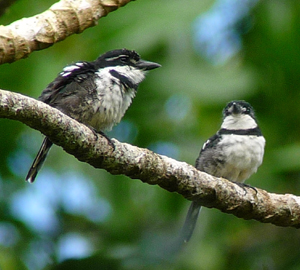 We looked at Scarlet-rumped Caciques and a Buff-throated Saltator from one of the bridges and then scoped a distant Plumbeous Kite flying with the Swallow-taileds. A family group of Red-throated Ant-tanagers moved through the forest understory coming out only for a brief view. A perched White-tailed Trogon was silhouetted in a tree and a Violet-crowned Woodnymph was showed better as it sat perched allowing prolonged views. We walked along the road stopping to admire a White Hawk that flew over and then played cat and mouse with a Bare-crowned Antbird that remained elusive only allowing quick views. High in the sky, a Gray Hawk was seen flying with two Plumbeous Kites and a pair of Pied Puffbirds (Photo: Gina Nichol) were well seen from the road as they sat on a high perch. We spent some time around another small bridge where a female Blue Cotinga showed well on a Cecropia tree. A Black-tailed Flycatcher was seen here and we enjoyed the antics of yet another Brown-throated Three-toed Sloth hanging upside down doing its morning preening routine.
We looked at Scarlet-rumped Caciques and a Buff-throated Saltator from one of the bridges and then scoped a distant Plumbeous Kite flying with the Swallow-taileds. A family group of Red-throated Ant-tanagers moved through the forest understory coming out only for a brief view. A perched White-tailed Trogon was silhouetted in a tree and a Violet-crowned Woodnymph was showed better as it sat perched allowing prolonged views. We walked along the road stopping to admire a White Hawk that flew over and then played cat and mouse with a Bare-crowned Antbird that remained elusive only allowing quick views. High in the sky, a Gray Hawk was seen flying with two Plumbeous Kites and a pair of Pied Puffbirds (Photo: Gina Nichol) were well seen from the road as they sat on a high perch. We spent some time around another small bridge where a female Blue Cotinga showed well on a Cecropia tree. A Black-tailed Flycatcher was seen here and we enjoyed the antics of yet another Brown-throated Three-toed Sloth hanging upside down doing its morning preening routine.
We moved the van further up the road and enjoyed a nice mid-morning coffee break. Steve walked up the main road and found a Royal Flycatcher that got away before anyone else saw it. On the way back, there was an Orchard Oriole on a flowering tree. We walked a small road along a farm fence and found a Pacific Antwren that showed well for us as well as a pair of Barred Antshrikes and a Plain Wren. A few steps further revealed a Rufescent Tiger Heron eating a small snake. Our next stop was at the Trogon Trail of the San Lorenzo National Park which yielded a Red-tailed Squirrel, Olivaceous Flatbill, two White-whiskered Puffbirds, Cocoa Woodcreeper, and Plain Xenops. A couple of Ruddy Quail Doves moved away quickly on the forest floor and a Lineated Woodpecker was spotted on the very top of a tree.
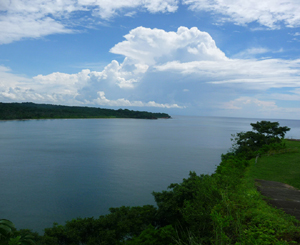 We had our picnic lunch at the entrance to San Lorenzo National Park and then drove to the abandoned fortress built by the Spanish in the late 1500s high atop the cliffs that overlook the Atlantic Ocean and the entrance to Rio Chagres. Recognized by UNESCO as a World Heritage Site, the fort was used as a military outpost and a prison where political leaders of Latin America's independence movement were held. Now it serves as a high vantage point overlooking the mouth of the Chagres River and the sea (Photo: Gina Nichol).
We had our picnic lunch at the entrance to San Lorenzo National Park and then drove to the abandoned fortress built by the Spanish in the late 1500s high atop the cliffs that overlook the Atlantic Ocean and the entrance to Rio Chagres. Recognized by UNESCO as a World Heritage Site, the fort was used as a military outpost and a prison where political leaders of Latin America's independence movement were held. Now it serves as a high vantage point overlooking the mouth of the Chagres River and the sea (Photo: Gina Nichol).
A Yellow Warbler greeted us in the car park and from the fort we could see Brown Pelicans, Neotropic Cormorants and two Yellow-crowned Night-Herons on various perches along the sea coast. A distant sleeping shorebird finally revealed itself as a Spotted Sandpiper and on the other side of the fort we could see a tree full of Great Egrets and Brown Pelicans across a little inlet.
We took a few minutes to enjoy the view and the surroundings when our driver Lorenzo came to inform us that he had found a Blue Cotinga. It turned out that he had found TWO stunning male Blue Cotingas which we enjoyed scope views of and got photos. As we gathered at the van for our departure, a Southern Beardless Tyrannulet appeared in the branches above. No quite the glamour bird that the Cotinga was but a tick nonetheless!
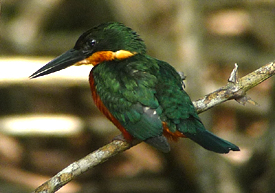 We moved to another area near some mangroves and walked along the road when all at once a kingfisher flew out of the mangroves and then back in a little further on. Green-and-Rufous Kingfisher! (Photo: Gina Nichol) Carlos followed and quickly found the bird which sat for several minutes just inside the trees allowing scope views and photos. Fantastic!
We moved to another area near some mangroves and walked along the road when all at once a kingfisher flew out of the mangroves and then back in a little further on. Green-and-Rufous Kingfisher! (Photo: Gina Nichol) Carlos followed and quickly found the bird which sat for several minutes just inside the trees allowing scope views and photos. Fantastic!
Later in the afternoon we found ourselves on the Panama Canal Railway enjoying a 48 mile ride across the Isthmus of Panama through lush jungles along the edge of the Panama Canal. Our railway car had been restored to be reminiscent of the golden age of railway travel. Originally built during the California Gold Rush, the Panama Canal Railway became an important link for passengers and freight between the Pacific and Atlantic Oceans.
There were many Snail Kites along the way and a crocodile was pointed out by the garrulous cruise ship commentator who was in our first class car with his own group. The scenery was nice despite the passing showers. Allan enjoyed the trip immensely sitting up and helping out the driver who turned out to be the manager of the railway line.
August 28 – Cerro Azul
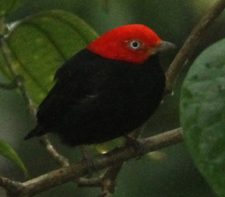 Another early start had us heading up the east side of the Panama Canal are to Cerro Azul foothills and the Chagres National Park to look for species not found in the Canal Zone. As we drove down Semaphore Hill we came upon a Common Opossum which soon disappeared up a bank. When we arrived at Cerro Azul it was quite misty but that didn’t dampen our spirits and we started the day with our first views of the endemic Striped-cheeked Woodpecker fairly high up in some trees. A Red-tailed Squirrel was an easier target as it climbed up a tree near the road. The area also produced Olivaceous Woodcreeper, Blue-black Grassquit, Paltry Tyrannulet, Long-billed Gnatwren, Bay-headed Tanager, Ruddy-tailed Flycatcher, Yellow-margined Flycatcher, Fulvous-vented Euphonia, and a nice male Red-capped Manakin (Photo: Steve Bird).
Another early start had us heading up the east side of the Panama Canal are to Cerro Azul foothills and the Chagres National Park to look for species not found in the Canal Zone. As we drove down Semaphore Hill we came upon a Common Opossum which soon disappeared up a bank. When we arrived at Cerro Azul it was quite misty but that didn’t dampen our spirits and we started the day with our first views of the endemic Striped-cheeked Woodpecker fairly high up in some trees. A Red-tailed Squirrel was an easier target as it climbed up a tree near the road. The area also produced Olivaceous Woodcreeper, Blue-black Grassquit, Paltry Tyrannulet, Long-billed Gnatwren, Bay-headed Tanager, Ruddy-tailed Flycatcher, Yellow-margined Flycatcher, Fulvous-vented Euphonia, and a nice male Red-capped Manakin (Photo: Steve Bird).
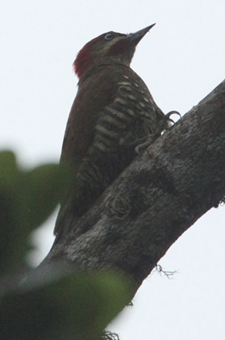 Moving on we spent a couple of hours birding around a lovely private home perched on the hillside overlooking Chagres National Park with a fantastic vista of the valley below. A Snowy-bellied Hummingbird was waiting as Carlos refilled its feeder. From the car park, we had Boat-billed Flycatcher, Yellow-crowned Euphonia, Tropical Pewee, and Olive-sided Flycatcher. On the other side of the house a Swallow-tailed Kite appeared drifting graceful up from the valley and soon up to 50 of these spectacular birds rose up out of the valley with one Plumbeous Kite mixed in. As fast as they appeared, the Kites disappeared down the valley. The feeders full, Yellow-faced Grassquits began visiting and there were several Variable Seedeaters around. A Rufous-tailed Hummingbird ruled the hummingbird feeders around the porch and then sat motionless for several minutes on a low branch as if to pose for photos. It was misty with intermittent rain but we didn’t mind in our comfortable surroundings sat outside under cover with the fabulous garden and view. A flock came through which included Hepatic Tanager, Bay-headed Tanager, a stunning Emerald Tanager, Red-capped Manakin, and Lesser Greenlet. We tried to leave but as we approached the back door a Black-striped Woodcreeper appeared close and soon there were three of these striking birds in the trees around us. While savoring our views of the Woodcreeper, a Russet Antshrike appeared and a female American Redstart got little notice. Another Stripe-cheeked Woodpecker (Photo: Steve Bird) made an appearance, this time very close to us allowing excellent views. Our plan soon changed and we stayed at this lovely private home an enjoyed a hot lunch prepared by Carlos and Lorenzo. Just as we began eating, another flock started to come through which included Speckled Tanager, Rufous-winged Tanager, Emerald Tanager, and more Bay-headed Tanagers. What a great place!
Moving on we spent a couple of hours birding around a lovely private home perched on the hillside overlooking Chagres National Park with a fantastic vista of the valley below. A Snowy-bellied Hummingbird was waiting as Carlos refilled its feeder. From the car park, we had Boat-billed Flycatcher, Yellow-crowned Euphonia, Tropical Pewee, and Olive-sided Flycatcher. On the other side of the house a Swallow-tailed Kite appeared drifting graceful up from the valley and soon up to 50 of these spectacular birds rose up out of the valley with one Plumbeous Kite mixed in. As fast as they appeared, the Kites disappeared down the valley. The feeders full, Yellow-faced Grassquits began visiting and there were several Variable Seedeaters around. A Rufous-tailed Hummingbird ruled the hummingbird feeders around the porch and then sat motionless for several minutes on a low branch as if to pose for photos. It was misty with intermittent rain but we didn’t mind in our comfortable surroundings sat outside under cover with the fabulous garden and view. A flock came through which included Hepatic Tanager, Bay-headed Tanager, a stunning Emerald Tanager, Red-capped Manakin, and Lesser Greenlet. We tried to leave but as we approached the back door a Black-striped Woodcreeper appeared close and soon there were three of these striking birds in the trees around us. While savoring our views of the Woodcreeper, a Russet Antshrike appeared and a female American Redstart got little notice. Another Stripe-cheeked Woodpecker (Photo: Steve Bird) made an appearance, this time very close to us allowing excellent views. Our plan soon changed and we stayed at this lovely private home an enjoyed a hot lunch prepared by Carlos and Lorenzo. Just as we began eating, another flock started to come through which included Speckled Tanager, Rufous-winged Tanager, Emerald Tanager, and more Bay-headed Tanagers. What a great place!
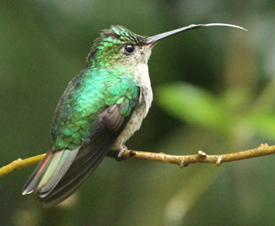 After lunch, we visited another private residence owned by friends of Gina’s from Connecticut. They invited us to check their feeders and put some bananas out and soon a Bronze-tailed Plumeleteer appeared followed by lots of White-necked Jacobins, a Violet-headed Hummingbird, and a Green Hermit. Thick-billed Euphonias had invaded the banana feeders and were joined by Plain-colored Tanagers and some Clay-colored Thrushes trying to establish dominance. The prize here was a Violet-capped Hummingbird (Photo: Steve Bird) that appeared and showed very well for us. This stop was a trip highlight for us – both the birds and the hospitality of our hosts.
After lunch, we visited another private residence owned by friends of Gina’s from Connecticut. They invited us to check their feeders and put some bananas out and soon a Bronze-tailed Plumeleteer appeared followed by lots of White-necked Jacobins, a Violet-headed Hummingbird, and a Green Hermit. Thick-billed Euphonias had invaded the banana feeders and were joined by Plain-colored Tanagers and some Clay-colored Thrushes trying to establish dominance. The prize here was a Violet-capped Hummingbird (Photo: Steve Bird) that appeared and showed very well for us. This stop was a trip highlight for us – both the birds and the hospitality of our hosts.
Later on, we headed back toward Panama City and made a stop at the coast to look for shorebirds. The tide was coming in but the sprawling mudflat was still exposed and it was crawling with birds. Scanning the many birds in attendance produced hundreds of Semipalmated Sandpipers, a few Marbled Godwits, several Whimbrels, a few Collared Plovers and an American Golden Plover in near full breeding plumage. In the distance over the deeper water were several Brown Pelicans, a few very distant Blue-footed Boobies, and many Magnificent Frigatebirds some of which flew close to us as they surveyed the shoreline. The tide was coming in fast as we scanned the garbage strewn shoreline and found a Ruddy Turnstone, many Short-billed Dowitchers, Spotted Sandpipers, Semipalmated Plovers, Willets, Lesser Yellowlegs, Black-necked Stilts, and Wilson’s Plover. We headed back toward the lodge picking up a juvenile Cocoi Heron standing on a bank near a bridge. When we reached the Tower, it was raining which forced our planned barbecue indoors.
August 29 – Canopy Tower, Pipeline Road, Travel to Canopy Lodge
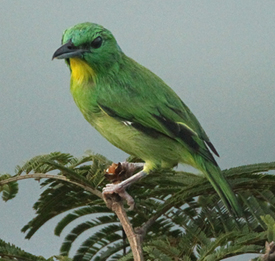 After breakfast we spent some time birding from the top of the Canopy Tower. Several Fulvous-vented Euphonias were working the tree tops and the Brown-throated Three-toed Sloth was still asleep in its Cecropia. There were Mealy Parrots perched on the bare tree with Blue-headed and Red-lored Parrots on some of the other branches. Carlos coaxed a Green Shrike-vireo (Photo: Steve Bird) to the tree tops allowing stunning views of this bird which is impossible to see when birding from the forest floor. Male and female Cinnamon Woodpeckers came in close and a band of six Collared Aracaris were spotted by Allan as they worked through a Cecropia. They moved around the tower and offered close views as they sparred with each other. Leonard pointed out a nice Sulphur-bellied Flycatcher perched close and all in all it was a lovely morning on the Tower.
After breakfast we spent some time birding from the top of the Canopy Tower. Several Fulvous-vented Euphonias were working the tree tops and the Brown-throated Three-toed Sloth was still asleep in its Cecropia. There were Mealy Parrots perched on the bare tree with Blue-headed and Red-lored Parrots on some of the other branches. Carlos coaxed a Green Shrike-vireo (Photo: Steve Bird) to the tree tops allowing stunning views of this bird which is impossible to see when birding from the forest floor. Male and female Cinnamon Woodpeckers came in close and a band of six Collared Aracaris were spotted by Allan as they worked through a Cecropia. They moved around the tower and offered close views as they sparred with each other. Leonard pointed out a nice Sulphur-bellied Flycatcher perched close and all in all it was a lovely morning on the Tower.
Later in the morning we went back to Pipeline Road, this time in the vehicle named “Shrike-Vireo” and drove beyond the locked gate (Canopy Tower has a key!) to position ourselves further along the road. We stopped at the Moustached Antwren spot and began to walk soon finding Checker-throated, White-flanked and Dot-winged Antwrens, Purple-throated Fruitcrow and Blue-crowned Manakin. A Black-tailed Trogon was calling from deeper in the forest so we walked by the calling Broad-billed Motmot to the edge of a small stream to try and locate it. A Slaty-tailed Trogon came in close and while we were watching that, Steve spotted the Black-tailed Trogon and we got scope views of it. A Streak-chested Antpitta called nearby and we located that bird quickly and got amazing views of this skulker.
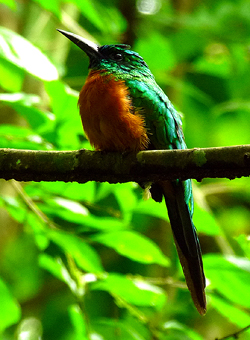 Back out on the road a Great Jacamar (Photo: Gina Nichol) was calling from a low perch allowing excellent views. What a morning! After a photo session with the Jacamar, we moved on along the road stopping for a couple of Gray-headed Tanagers and soon found ourselves parked right in the middle of an Army Ant swarm. In attendance were Bicolored Antbirds, Spotted Antbird, and a Rufous Mourner. We watched at unbelievable close range as the birds snatched insects that were being disturbed by the ants. A Speckled Mourner also showed very well allowing excellent views of this rare bird! It was time to head back to the lodge for lunch and as an added bonus Carlos found another Green-and-Rufous Kingfisher at Juan Grande bridge just off the parking lot! This was one of those mornings that Pipeline Road is famous for!
Back out on the road a Great Jacamar (Photo: Gina Nichol) was calling from a low perch allowing excellent views. What a morning! After a photo session with the Jacamar, we moved on along the road stopping for a couple of Gray-headed Tanagers and soon found ourselves parked right in the middle of an Army Ant swarm. In attendance were Bicolored Antbirds, Spotted Antbird, and a Rufous Mourner. We watched at unbelievable close range as the birds snatched insects that were being disturbed by the ants. A Speckled Mourner also showed very well allowing excellent views of this rare bird! It was time to head back to the lodge for lunch and as an added bonus Carlos found another Green-and-Rufous Kingfisher at Juan Grande bridge just off the parking lot! This was one of those mornings that Pipeline Road is famous for!
After lunch we departed Canopy Tower for Canopy Lodge situated in the crater of an extinct volcano in the village of El Valle de Anton. The lodge sits in the foothills in eastern edge of the Talamanca range that stretches westward into Costa Rica. Contiguous to the protected area of the Cerro Gaital National Monument, the lodge is located in Raul Arias de Para’s home town of El Valle. As we approached the village of El Valle we drove into heavy rain which had obviously been going for some time by the fast flowing, brown river that flowed near the road at the edge of town. Carlos told us that it was our river and sure enough as we reached the lodge, the river was roaring. We settled in to our beautiful surroundings as Carlos put out bananas that enticed Thick-billed Euphonias, Blue-gray Tanagers and a Rufous-capped Warbler. Later on we met for an excellent dinner and to catch up on our checklist of today’s sightings.
August 30 –Canopy Lodge and surroundings
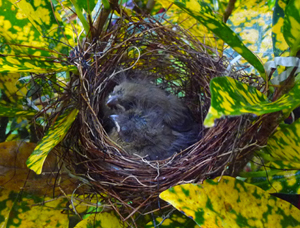 In the morning, we were up and checking the feeders before breakfast. Thick-billed Euphonias were once again in abundance, joined at one point by another Rufous-capped Warbler. One of the shrubs in the garden held a nest of a pair of Variable Seedeaters (Photo: Gina Nichol). On further observation, we could see two well grown chicks in the nest and by the next day, they had fledged. The river flow had subsided and now the water was clear and a Louisiana Waterthrush was seen from the footbridge over the river. A Red-crowned Woodpecker and a few Bananaquits visited the feeder as did a female Green Honeycreeper. After breakfast, we spent the morning birding the area below El Gaital walking a road surrounded by forest that offered Black-striped Sparrow, Chestnut-backed Antbird, White-breasted Wood Wren, and Spotted Woodcreeper. A small trail into the forest produced a very confiding White-throated Spadebill and a Black-capped Antpitta that came in very close but remained out of view.
In the morning, we were up and checking the feeders before breakfast. Thick-billed Euphonias were once again in abundance, joined at one point by another Rufous-capped Warbler. One of the shrubs in the garden held a nest of a pair of Variable Seedeaters (Photo: Gina Nichol). On further observation, we could see two well grown chicks in the nest and by the next day, they had fledged. The river flow had subsided and now the water was clear and a Louisiana Waterthrush was seen from the footbridge over the river. A Red-crowned Woodpecker and a few Bananaquits visited the feeder as did a female Green Honeycreeper. After breakfast, we spent the morning birding the area below El Gaital walking a road surrounded by forest that offered Black-striped Sparrow, Chestnut-backed Antbird, White-breasted Wood Wren, and Spotted Woodcreeper. A small trail into the forest produced a very confiding White-throated Spadebill and a Black-capped Antpitta that came in very close but remained out of view.
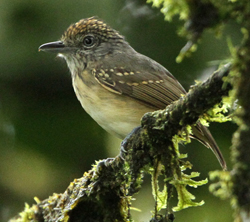 Further up the hill, an Orange-bellied Trogon was calling and soon seen well in the scope. In the same area we found Squirrel Cuckoo, a few Silver-throated Tanagers, Bronze-tailed Plumeleteer, Bay-headed Tanager, and a female Spot-crowned Antvireo (Photo: Steve Bird) that was seen well and photographed. Further on there were some open fields which held several Eastern Meadowlarks as well as a female Thick-billed Seed Finch and a Bran-colored Flycatcher. An interesting call produced a Wedge-tailed Grass Finch which flew off quickly staying hidden after it landed in the tall grass. There was a nice view out to the Pacific ocean beyond the valley and the sprawling coastal plain. Above a nearby ridge, Swallow-tailed and Plumbeous Kites were on the wing. Walking back down we added Tawny-crested and Dusky-faced Tanagers in a flock that moved through quickly, and we got varying looks at a pair of Red-crowned Ant Tanager. Continuing on, the same flock seemed to be following us and came close to the road offering Dusky-capped Flycatcher as well.
Further up the hill, an Orange-bellied Trogon was calling and soon seen well in the scope. In the same area we found Squirrel Cuckoo, a few Silver-throated Tanagers, Bronze-tailed Plumeleteer, Bay-headed Tanager, and a female Spot-crowned Antvireo (Photo: Steve Bird) that was seen well and photographed. Further on there were some open fields which held several Eastern Meadowlarks as well as a female Thick-billed Seed Finch and a Bran-colored Flycatcher. An interesting call produced a Wedge-tailed Grass Finch which flew off quickly staying hidden after it landed in the tall grass. There was a nice view out to the Pacific ocean beyond the valley and the sprawling coastal plain. Above a nearby ridge, Swallow-tailed and Plumbeous Kites were on the wing. Walking back down we added Tawny-crested and Dusky-faced Tanagers in a flock that moved through quickly, and we got varying looks at a pair of Red-crowned Ant Tanager. Continuing on, the same flock seemed to be following us and came close to the road offering Dusky-capped Flycatcher as well.
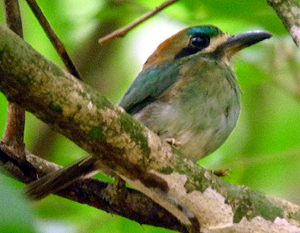 Our afternoon plan was to bird the Cara Iguana Trail to sample some foothill birding in the dry Pacific forest. On the way we made a stop at a private home to see two Tropical Screech-Owls roosting in a pine tree. The birds were perched together under a bromeliad and one lazily opened its eyes as we watched them from below. As we were watching the birds from different angles, two Bat Falcons flew over calling. Our host also showed us a Hummingbird nest with one very young chick and one egg still yet to hatch. As we worked our way out to the road, Allan found a Long-billed Starthroat working some flowers on a tree and we got good views of this bird as it perched on an open branch. Next up was a Rufous-and-White Wren that was calling from some thick understory off a little side road and soon came into view and flitted around for us. We moved back out to the main track and enjoyed fantastic views of a Tody Motmot (Photo: Carlos Bethancourt) that was calling nearby. At one point, it flew across directly at Gina and then veered up into the branches above. A Pale-eyed Pygmy Tyrant was also seen in the area and further on one of the Bat Falcon was seen perched and preening on an open branch. We stopped to survey an open field area where a group of Chestnut-headed Oropendolas were moving through. On the way back down we crossed paths with a group of Lance-tailed Manakins – an adult male and female and a vocal young male. Great views!
Our afternoon plan was to bird the Cara Iguana Trail to sample some foothill birding in the dry Pacific forest. On the way we made a stop at a private home to see two Tropical Screech-Owls roosting in a pine tree. The birds were perched together under a bromeliad and one lazily opened its eyes as we watched them from below. As we were watching the birds from different angles, two Bat Falcons flew over calling. Our host also showed us a Hummingbird nest with one very young chick and one egg still yet to hatch. As we worked our way out to the road, Allan found a Long-billed Starthroat working some flowers on a tree and we got good views of this bird as it perched on an open branch. Next up was a Rufous-and-White Wren that was calling from some thick understory off a little side road and soon came into view and flitted around for us. We moved back out to the main track and enjoyed fantastic views of a Tody Motmot (Photo: Carlos Bethancourt) that was calling nearby. At one point, it flew across directly at Gina and then veered up into the branches above. A Pale-eyed Pygmy Tyrant was also seen in the area and further on one of the Bat Falcon was seen perched and preening on an open branch. We stopped to survey an open field area where a group of Chestnut-headed Oropendolas were moving through. On the way back down we crossed paths with a group of Lance-tailed Manakins – an adult male and female and a vocal young male. Great views!
On the way back to the lodge, we stopped at the Chorro Macho waterfall, a beautiful cascade falling 118 ft down a hillside. The prize here was a White-tipped Sicklebill roosting on a small branch growing out of the side of the gorge. It was a fabulous site, not far off, with the waterfall in the background. A superb way to end the day!
August 31 – Altos del Maria
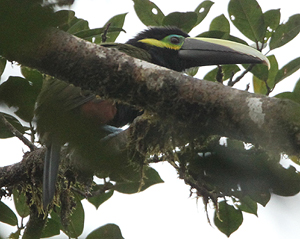 Today we drove up into mountains on the continental divide east of El Valle and the wet forest 3,000 feet above sea level to a private area known as Los Altos del Maria. As we crossed the Rio Chame, a Ringed Kingfisher was seen perched on a power line and a Spotted Sandpiper bobbed up and down on a rock. It was a lovely day but as we ascended into the mountains we drove into clouds and as we arrived at our first birding spot we were shrouded in fog. This made it difficult to get any color on the birds but still we were able to find a Blue-throated Toucanet, Rufous-capped Warbler, a female Violet-crowned Woodnymph, and Gray-breasted Wood Wren. A Black-and-yellow Tanager looked somewhat gray and there were numerous White-vented Euphonias and a few Tufted Flycatchers around and showing well. A Rufous Mourner appeared in the mist and a White Hawk flew out of the fog and perched low for us. The highlight was a pair of Yellow-eared Toucanets (Photo: Steve Bird) that flew in and had us chasing them for decent views. At that point, the rain closed in and was falling quite heavily so we drove down the mountain to another area. Still raining we sat for a few moments to wait it out. It wasn’t long before the skies brightened and we were back up the road watching a young male White-ruffed Manakin and seeing our first Red-faced Spinetail. A Brown-billed Scythebill called nearby and eventually flew across the road disappearing into the trees on the other side. As Carlos and Danillo prepared our picnic lunch, Gina found a White-throated Spadebill in the forest nearby. We enjoyed our lunch on the quiet road and were soon out birding again with a flock of Common Bush-Tanagers that got us going again. Meanwhile, Danillo was scouting another road and came back to report that he had found Snowcap. We moved quickly and set up scopes to watch not one, but three Snowcaps – a male, female, and a juvenile male feeding on the flowers of a tree. The birds moved quickly but eventually we all got reasonable views. All at once a Green Thorntail came in and fought with one of the Snowcaps making for an exciting avian drama. Just up the hill we found a Pale-vented Thrush and a Rufous-browed Tyrannulet before departing the area.
Today we drove up into mountains on the continental divide east of El Valle and the wet forest 3,000 feet above sea level to a private area known as Los Altos del Maria. As we crossed the Rio Chame, a Ringed Kingfisher was seen perched on a power line and a Spotted Sandpiper bobbed up and down on a rock. It was a lovely day but as we ascended into the mountains we drove into clouds and as we arrived at our first birding spot we were shrouded in fog. This made it difficult to get any color on the birds but still we were able to find a Blue-throated Toucanet, Rufous-capped Warbler, a female Violet-crowned Woodnymph, and Gray-breasted Wood Wren. A Black-and-yellow Tanager looked somewhat gray and there were numerous White-vented Euphonias and a few Tufted Flycatchers around and showing well. A Rufous Mourner appeared in the mist and a White Hawk flew out of the fog and perched low for us. The highlight was a pair of Yellow-eared Toucanets (Photo: Steve Bird) that flew in and had us chasing them for decent views. At that point, the rain closed in and was falling quite heavily so we drove down the mountain to another area. Still raining we sat for a few moments to wait it out. It wasn’t long before the skies brightened and we were back up the road watching a young male White-ruffed Manakin and seeing our first Red-faced Spinetail. A Brown-billed Scythebill called nearby and eventually flew across the road disappearing into the trees on the other side. As Carlos and Danillo prepared our picnic lunch, Gina found a White-throated Spadebill in the forest nearby. We enjoyed our lunch on the quiet road and were soon out birding again with a flock of Common Bush-Tanagers that got us going again. Meanwhile, Danillo was scouting another road and came back to report that he had found Snowcap. We moved quickly and set up scopes to watch not one, but three Snowcaps – a male, female, and a juvenile male feeding on the flowers of a tree. The birds moved quickly but eventually we all got reasonable views. All at once a Green Thorntail came in and fought with one of the Snowcaps making for an exciting avian drama. Just up the hill we found a Pale-vented Thrush and a Rufous-browed Tyrannulet before departing the area.
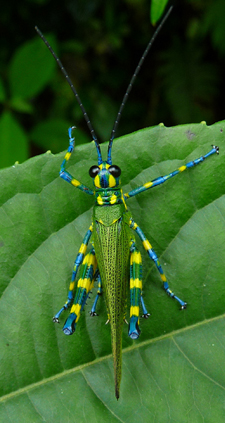 Our next stop was in the spot where we had waited out the rain, a place called Mirador Monte Azul. We walked up the track and found an amazing looking grasshopper, later identified as Chromacris speciosa (Photo: Gina Nichol). After a photo session with this glamour bug, we continued on and found Olive-sided Flycatcher and Slate-colored Grosbeak and a small boardwalk produced a female White-tailed Emerald, a feeding Bronze-tailed Plumeleteer, and a quick glimpse of a Scarlet-thighed Dacnis. All in all, a good birding day with some nice species despite the weather.
Our next stop was in the spot where we had waited out the rain, a place called Mirador Monte Azul. We walked up the track and found an amazing looking grasshopper, later identified as Chromacris speciosa (Photo: Gina Nichol). After a photo session with this glamour bug, we continued on and found Olive-sided Flycatcher and Slate-colored Grosbeak and a small boardwalk produced a female White-tailed Emerald, a feeding Bronze-tailed Plumeleteer, and a quick glimpse of a Scarlet-thighed Dacnis. All in all, a good birding day with some nice species despite the weather.
September 1 – El Chiru
Today we traveled to the Pacific side of the Cocle Province of central Panama to bird the rice fields, agricultural areas, lowland marshes, dry forests and coastline. Our first stop was along a flat farm road where we found Red-breasted Blackbirds and Eastern Meadowlarks in a cow field. Two Yellow-headed Caracaras were perched in a palm and a White-tailed Kite was scoped on a bare tree. A couple of Savannah Hawks were seen as were a few Crested Caracaras. The trees and agricultural areas along the road held Yellow-green Vireo, Lesser Goldfinch, Yellow-bellied Seedeater, Groove-billed Ani, and Blue-black Grassquit. A small group of Black-bellied Whistling Ducks flew over as we turned off the main road to look for a Ferruginous Pygmy Owl that was calling in the distance. Two Rufous-browed Peppershrikes did their best to avoid detection as we walked along a farm path. There were possibly three Ferruginous Pygmy Owls calling and being mobbed by Common Tody Flycatchers and Clay-colored Thrushes. A Sapphire-throated Hummingbird seemed to be mobbing an owl as well and while we could see the hummingbird well, the owl remained hidden. We walked around to get another perspective on the three and though it was further away, Steve spotted the owl between two branches and we managed scope views! Amazing!
Back out along the road we found Streaked Saltator, a couple of Scrub Greenlets, Panama Flycatcher, Acadian Flycatcher, Red-eyed Vireo, and Lesser Elaenia. Some Brown-throated Parakeets were flying around and offered great views when they landed on top of a tree near the road. Meanwhile, a Crested Bobwhite got away before most had a chance to see it.
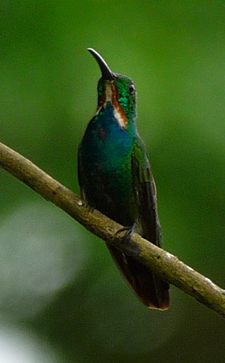 We moved on stopping near a small farm pond with a Green Kingfisher sat on a bank. Our next stop was a rice farming operation and as Carlos asked permission for us to drive in we found our obligatory House Sparrows for the trip. We birded the rice field area to find Crested Caracaras, a few Cattle Egrets and an immature White Ibis atop a Cecropia. We crossed a large flooded puddle and drove to another area among the rise fields. A Gray-necked Wood Rail crossed the road in front of us and at the next junction we saw several Lesser Yellow-headed Vultures flying around. A Green Kingfisher posed for photos near culvert under the road and a little further along the path we found the first of five Veraguan Mangos (Photo: Gina Nichol)! The bird was extremely showy perching on open branches for extended periods in between feeding on the heliconias below. It was a fantastic show! A Sapphire-throated Hummingbird was also in the area and equally showy. Remarkable! We walked a little further on adding a Wood Stork that flew over as did a Glossy Ibis.
We moved on stopping near a small farm pond with a Green Kingfisher sat on a bank. Our next stop was a rice farming operation and as Carlos asked permission for us to drive in we found our obligatory House Sparrows for the trip. We birded the rice field area to find Crested Caracaras, a few Cattle Egrets and an immature White Ibis atop a Cecropia. We crossed a large flooded puddle and drove to another area among the rise fields. A Gray-necked Wood Rail crossed the road in front of us and at the next junction we saw several Lesser Yellow-headed Vultures flying around. A Green Kingfisher posed for photos near culvert under the road and a little further along the path we found the first of five Veraguan Mangos (Photo: Gina Nichol)! The bird was extremely showy perching on open branches for extended periods in between feeding on the heliconias below. It was a fantastic show! A Sapphire-throated Hummingbird was also in the area and equally showy. Remarkable! We walked a little further on adding a Wood Stork that flew over as did a Glossy Ibis.
We drove out of the rice farm stopping at another pond to look at a Lesser Elaenia, another Wood Stork and a Purple Gallinule. A roadside stop along Pacific Coast yielded a Common Black Hawk and we walked out to the beach to see Willets, Sanderlings and a few Whimbrels. Large flocks of Neotropic Cormorants were moving over the sea and there was the odd Brown Pelican and Magnificent Frigatebird around. Another side road running between the beach and an agricultural field produced a very confiding Pale-breasted Spinetail and some Fork-tailed Flycatchers.
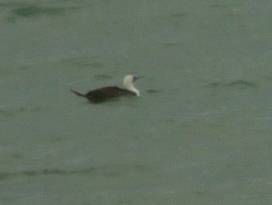 We finally settled at Juan Hombron Beach for our picnic lunch. An American Oystercatcher was new here and we scanned the seabirds and found Blue-footed and Brown Booby among the Pelicans and Magnificent Frigatebirds. After lunch, Gina sat and scanned the sea picking up an interesting bird that was apparently seen earlier by Carlos and Christian but dismissed. She called everyone over to examine it as it sat on the water for a time and then took flight which Carlos captured on video. It was later confirmed as a Peruvian Booby (Photo: Carlos Bethancourt), the first for Panama since 1984! What a coup!
We finally settled at Juan Hombron Beach for our picnic lunch. An American Oystercatcher was new here and we scanned the seabirds and found Blue-footed and Brown Booby among the Pelicans and Magnificent Frigatebirds. After lunch, Gina sat and scanned the sea picking up an interesting bird that was apparently seen earlier by Carlos and Christian but dismissed. She called everyone over to examine it as it sat on the water for a time and then took flight which Carlos captured on video. It was later confirmed as a Peruvian Booby (Photo: Carlos Bethancourt), the first for Panama since 1984! What a coup!
We packed up and headed out along a wooded road. Carlos’ sharp ears picked up the call of a Straight-billed Woodcreeper and soon we were looking at it working up the trunk of a tree. Further on, we stopped for a Plain-breasted Ground Dove that Carlos spotted in a tree, another for our burgeoning list! On the way back to the lodge, we spent some time at a private beach house, a beautiful, relaxing setting and a nice end to another extraordinary day!
September 1 – Jordanal
Today we traveled by 4-wheel drive to the village of Jordanal, on the Caribbean slope at the very western edge of Panama Province. We navigated a newly built “road” forging several streams into the interior foothills. Our first stop was for a small flock of Dusky-faced Tanagers that got away quickly. We stopped at the top of a hill where we scoped a Scarlet-thighed Dacnis and scanned the flowering trees for hummingbirds. Birds here included Cinnamon Becard, Gray-capped Flycatcher, Golden-hooded Tanager, Plain-colored Tanager, Black-and-White Warbler, Green Thorntail, and Blue-headed Parrot. Janice spotted a distant tree with at least 18 Swallow-tailed Kites perched and a Short-tailed Hawk soared over a distant ridge. White-necked Jacobin, Green Honeycreeper, and Shining Honeycreeper were also in the area.
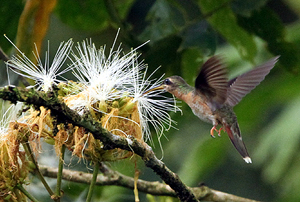 Carlos had wandered down the hill and soon called us down to see a Rufous-crested Coquette feeding in an Inga tree. By the time we arrived, the bird had vanished so we staked out the tree and waited for it to return. In the meantime, we added a couple of Masked Tityras, Wedge-billed Woodcreeper, Green Thorntail, Blue-chested Hummingbird, and a Rufous-breasted Hermit (Photo: Steve Bird) that was tending a nest. Finally, Steve spotted the tiny Rufous-crested Coquette feeding in the flowers on the other side and we scrambled for views. The bird moved all too quickly and when it disappeared we spent some more time waiting for it to return. It did not but we did add Fulvous-vented Euphonias, Bay Wren, and Yellow-green Vireo before moving on.
Carlos had wandered down the hill and soon called us down to see a Rufous-crested Coquette feeding in an Inga tree. By the time we arrived, the bird had vanished so we staked out the tree and waited for it to return. In the meantime, we added a couple of Masked Tityras, Wedge-billed Woodcreeper, Green Thorntail, Blue-chested Hummingbird, and a Rufous-breasted Hermit (Photo: Steve Bird) that was tending a nest. Finally, Steve spotted the tiny Rufous-crested Coquette feeding in the flowers on the other side and we scrambled for views. The bird moved all too quickly and when it disappeared we spent some more time waiting for it to return. It did not but we did add Fulvous-vented Euphonias, Bay Wren, and Yellow-green Vireo before moving on.
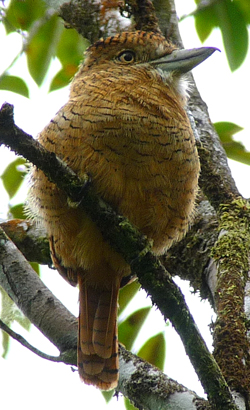 Our next stop was for a Slate-colored Seedeater that flitted quickly among the branches and soon flew to the tree tops and out of site. While we were chasing it, Steve walked up the road and found a Barred Puffbird (Photo: Gina Nichol) perched in a tree just near the road. It posed for several minutes allowing prolonged views and photos. Stunning!
Our next stop was for a Slate-colored Seedeater that flitted quickly among the branches and soon flew to the tree tops and out of site. While we were chasing it, Steve walked up the road and found a Barred Puffbird (Photo: Gina Nichol) perched in a tree just near the road. It posed for several minutes allowing prolonged views and photos. Stunning!
We bounced our way back for lunch and spent a little time enjoying the lodge before heading out to the Canopy Adventure trails which were quiet except for an inquisitive Bay Wren, a close Barred Antshrike, and a Violet-crowned Woodnymph guarding its Vervain bush. We had a little time left so moved up to La Mesa adding Sulphur-bellied Flycatcher, Rufous-tailed Hummingbird, Plain Antvireo, Scale-crested Pygmy Tyrant, and Keel-billed Toucan to our day list.
In the evening, we enjoyed our final dinner and reminisced about all of the wonderful sightings and experiences we had during our time in Panama.
September 3 - Departures
Today we departed El Valle to Panama City. Our last bird of the trip was a Pearl Kite perched on a power line along the road. At the airport we said goodbye to our fantastic guide Carlos and headed home with a great list of birds seen in Panama.
It was a great pleasure to explore the avian life in Panama with this group and the Canopy Tower and Lodge are simply wonderful. Our guide Carlos was superb, a true professional who knows the birds and where to find them. It was an excellent tour and we look forward to our next visit to this friendly, bird-filled country!
Gina and Steve